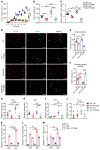Lactate inhibits ATP6V0d2 expression in tumor-associated macrophages to promote HIF-2α-mediated tumor progression
- PMID: 30431439
- PMCID: PMC6355226
- DOI: 10.1172/JCI123027
Lactate inhibits ATP6V0d2 expression in tumor-associated macrophages to promote HIF-2α-mediated tumor progression
Abstract
Macrophages perform key functions in tissue homeostasis that are influenced by the local tissue environment. Within the tumor microenvironment, tumor-associated macrophages can be altered to acquire properties that enhance tumor growth. Here, we found that lactate, a metabolite found in high concentration within the anaerobic tumor environment, activated mTORC1 that subsequently suppressed TFEB-mediated expression of the macrophage-specific vacuolar ATPase subunit ATP6V0d2. Atp6v0d2-/- mice were more susceptible to tumor growth, with enhanced HIF-2α-mediated VEGF production in macrophages that display a more protumoral phenotype. We found that ATP6V0d2 targeted HIF-2α but not HIF-1α for lysosome-mediated degradation. Blockade of HIF-2α transcriptional activity reversed the susceptibility of Atp6v0d2-/- mice to tumor development. Furthermore, in a cohort of patients with lung adenocarcinoma, expression of ATP6V0d2 and HIF-2α was positively and negatively correlated with survival, respectively, suggesting a critical role of the macrophage lactate/ATP6V0d2/HIF-2α axis in maintaining tumor growth in human patients. Together, our results highlight the ability of tumor cells to modify the function of tumor-infiltrating macrophages to optimize the microenvironment for tumor growth.
Keywords: Immunology; Lysosomes; Macrophages; Oncology.
Conflict of interest statement
Figures








References
Publication types
MeSH terms
Substances
LinkOut - more resources
Full Text Sources
Other Literature Sources
Medical
Molecular Biology Databases

